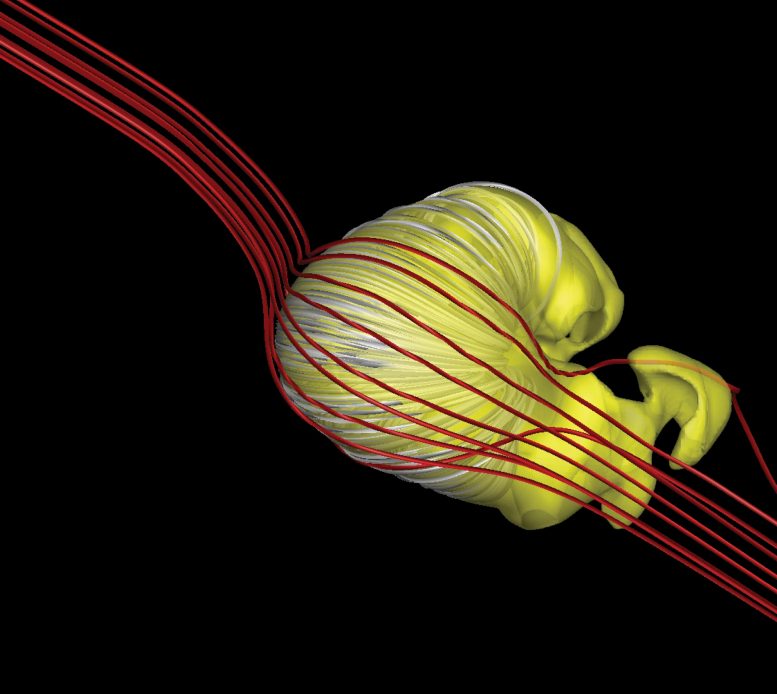New research led by BU astrophysicist Merav Opher could explain why the heliosphere, a protective magnetic “force field” emanating from our sun and encompassing our solar system, is likely unstable and irregularly shaped. “The universe is not quiet,” Opher says. “Our BU model doesn’t try to cut out the chaos.” Credit: Merav Opher, et. al
Astrophysicists on BU’s
Is this what the heliosphere looks like? BU-led research suggests so. The size and shape of the magnetic “force field” that protects our solar system from deadly cosmic rays has long been debated by astrophysicists. Credit: Opher, et al
Since BU’S NASA DRIVE Science Center first received funding in 2019, Opher’s SHIELD team has hunted for answers to several puzzling questions: What is the overall structure of the heliosphere? How do its ionized particles evolve and affect heliospheric processes? How does the heliosphere interact and influence the interstellar medium, the matter and radiation that exists between stars? And how do cosmic rays get filtered by, or transported through, the heliosphere?
“SHIELD combines theory, modeling, and observations to build comprehensive models,” Opher says. “All these different components work together to help understand the puzzles of the heliosphere.”
And now a paper published by Opher and collaborators in Astrophysical Journal reveals that neutral hydrogen particles streaming from outside our solar system most likely play a crucial role in the way our heliosphere takes shape.
In their latest study, Opher’s team wanted to understand why heliospheric jets—blooming columns of energy and matter that are similar to other types of cosmic jets found throughout the universe—become unstable. “Why do stars and black holes—and our own sun—eject unstable jets?” Opher says. “We see these jets projecting as irregular columns, and [astrophysicists] have been wondering for years why these shapes present instabilities.”
Similarly, SHIELD models predict that the heliosphere, traveling in tandem with our sun and encompassing our solar system, doesn’t appear to be stable. Other models of the heliosphere developed by other astrophysicists tend to depict the heliosphere as having a comet-like shape, with a jet—or a “tail”—streaming behind in its wake. In contrast, Opher’s model suggests the heliosphere is shaped more like a croissant or even a donut.
The reason for that? Neutral hydrogen particles, so-called because they have equal amounts of positive and negative charge that net no charge at all.
“They come streaming through the solar system,” Opher says. Using a computational model like a recipe to test the effect of ‘neutrals’ on the shape of the heliosphere, she “took one ingredient out of the cake—the neutrals—and noticed that the jets coming from the sun, shaping the heliosphere, become super stable. When I put them back in, things start bending, the center axis starts wiggling, and that means that something inside the heliospheric jets is becoming very unstable.”
Instability like that would theoretically cause disturbance in the solar winds and jets emanating from our sun, causing the heliosphere to split its shape—into a croissant-like form. Although astrophysicists haven’t yet developed ways to observe the actual shape of the heliosphere, Opher’s model suggests the presence of neutrals slamming into our solar system would make it impossible for the heliosphere to flow uniformly like a shooting comet. And one thing is for sure—neutrals are definitely pelting their way through space.
Drake, a coauthor on the new study, says Opher’s model “offers the first clear explanation for why the shape of the heliosphere breaks up in the northern and southern areas, which could impact our understanding of how galactic cosmic rays come into Earth and the near-Earth environment.” That could affect the threat that radiation poses to life on Earth and also for astronauts in space or future pioneers attempting to travel to (function(d, s, id){
var js, fjs = d.getElementsByTagName(s)[0];
if (d.getElementById(id)) return;
js = d.createElement(s); js.id = id;
js.src = "https://connect.facebook.net/en_US/sdk.js#xfbml=1&version=v2.6";
fjs.parentNode.insertBefore(js, fjs);
}(document, 'script', 'facebook-jssdk'));
Read original article here
